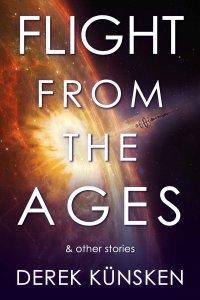Paul Di Filippo Reviews Flight from the Ages & other stories by Derek Künsken
 Flight from the Ages & other stories, Derek Künsken (Solaris 978-1786187284, trade paperback, 400pp, $16.99) December 2022.
Flight from the Ages & other stories, Derek Künsken (Solaris 978-1786187284, trade paperback, 400pp, $16.99) December 2022.
It does one’s heart good to see newer writers working in some of the grand traditions of SF, reinvigorating the Old School lineage with up-to-the-minute attitudes, concepts, and styles. Such a writer is Derek Künsken. Although not a youngster (he was born in 1971), he possesses a fresh and breezy way with a tale.
Although I am not totally up to speed on Künsken’s major achievement to date, the Quantum Evolution saga, I have managed to enjoyably read the first volume, The Quantum Magician, and this limited foray into his continuum allows me better to appreciate the stories in his new book which occur in that venue. Most of the tales have only a non-obvious implicit link, though a couple are set smack-dab in the middle of his ongoing saga. So, even from a vantage of complete unfamiliarity with Künsken’s universe, I would not hesitate to buy this fine collection. The stories herein are all appreciable on their own merits by any keen-witted reader.
Just briefly, a word or three about the Quantum Evolution setup, as I derived it from that first volume.
Far in the future, several polities—the Congregate, the Union, the Anglo-Spanish Plutocracy—contend for power and influence and riches. Humanity has splintered into at least three distinct strains: Homo quantus, Homo pupa, and Homo eridanus. Our hero of the trilogy is one Belisarius, a Homo quantus, whose brain and body are attuned to the essential forces of the universe, which he can interpolate and navigate and manipulate. The Quantum Magician is essentially a heist caper, in which a motley crew of conspirators work to achieve a surface goal—allowing some battleships to traverse interdicted zones of space—while also aiming to master the process of time travel.
It would exhibit a lack of critical perspicuity for me not to mention that Künsken, on first superficial glance, treads a little close to another writer’s domain, since his book features a posthuman con man under the rubric The Quantum Magician, comparable to Hannu Rajaniemi’s The Quantum Thief, and its similar protagonist. But ultimately, before too many pages have passed, Künsken establishes the novelty and differences of his own vision, approaching a blend of Alistair Reynolds and the nigh-forgotten Ian Wallace, whose van-Vogtian Croyd and sequels resonate here. And, after all, you can’t patent a good trope or title.
Here’s a Wallacian instance, concerning Belisarius’s quantus peer, Cassandra.
The Cassandra subjectivity extinguished on the bridge of the Limpopo; the quantum intellect congealed in the absence. Perception expanded beyond the hull. Tangled particle and wave interactions rippled in the ambient magnetic field, pressing against millions of magnetosomes embedded in the cells of the Cassandra physicality. Waves of interfering probability built a picture of layered quantum states in the region around the Limpopo. Within point three one seconds, the mouth of the Port Stubbs worm hole began affecting the probabilities reaching the quantum intellect. And the darting movements of Puppet ships showed themselves by the way they bled small amounts of energy into the pulsar’s magnetic field. The Puppet fortifications showed in outline, mixing their electrical emissions into the faint press of magnetism.
The author offers a handy future history timeline for his universe at this link, helping us navigate these stories.
First up is “Beneath Sunlit Shallows”. Our hero, a fellow named Vincent living in a colony on an alien planet, has sacrificed his baseline humanity to become a benthic-dwelling sea creature (forerunner of Homo eridanus, it seems). He is not entirely happy about this situation, especially when it appears that his new form is subject to rampant cancers. But placing the survival of his colony above himself, he eventually reaches an accommodation. The physicality of the marine environment is keenly wrought, and the psychological touches are highly believable. One is reminded, in a favorable comparison, of Bryant’s classic “Shark”.
“Schools of Clay” outdoes Stephen Baxter in its depiction of a hive-like existence among various strange beings—skates, their princesses, the predatory shaghal—who live nearby a pulsar. I love the notion of having removable souls, which serve to upgrade a being’s mentality and nature. Our hero, Diviya, is totally relatable, despite his alien conformation and realities.
“Persephone Descending” summons up Clarke’s famous “A Meeting with Medusa”. But instead of exploring the atmosphere of Jupiter, Künsken transports us to a cognate realm on Venus. Marie-Claude is a worker in the relatively safe upper reaches of this hell-planet. But as things go pear-shaped, and she begins to fall uncontrollable through the strata of the skies, she must summon up all her ingenuity and bravery to survive. The creatures of Venus and their ecology are cleverly imagined, and Marie-Claude’s character is Andy-Weir-rich.
The next tale, “Pollen From a Future Harvest”, is one set roughly at the same time as The Quantum Magician, and even features some of the same characters and the same recomplicated science. “Vegetable intelligences…lived around the time gates, sending their pollen into the past…”
The events in the title story actually occur at the remotest remove so far of Künsken’s future history. An AI named Ulixes-316 must confront the arrival of dangerous alien tech: “The shine of purple tachyons erupted from Poluphemos’ position, traveling backward in time and transparently through them, except for the shadows cast by the six microscopic black holes in the two ships…and at the Sauronati mine.”
Wrapping up the volume is the low-key-Stapledonian “Tool Use By Humans of Danzhai County”, which takes up fully a quarter of the book. Starting in the year 2010 and concluding in the year 2095, this story—benefiting, as we learn in an afterword, from Künsken’s personal experience in China—offers the core thrills of SF: a sense of the power of progress and the estrangements it brings.
He didn’t recognize anything of Danzhai except the giant birdcage on the mountain. Tall apartment buildings stood beside wide streets that moved with AI-driven cars, buses, and four-wheeled scooters. Big factories stood on the outskirts of the city, with train tracks running in and out, and helipads on the roofs. In the distance, four-rotor drone cars moved in straight lines, high above the city, like they did in Guiyang, like subways and train routes in the air, little red and green running lights winking.
As he’d seen in the pictures, people wore jeans and modern skirts with abstract Miao designs, as well as stylish coats and shirts with embroidered phoenix figures and golden peacocks. Children wore big glasses that carried their personal AIs, projecting augmented reality onto the lenses. Who knew how the children of today played with each other? Were they playing games with each other, or with children in nearby villages, or Guiyang or Hangzhou?
So long as authors arrive regularly in fantastika who thrill to such frissons, and can ably convey them, the genre will remain in safe hands.
 While you are here, please take a moment to support Locus with a one-time or recurring donation. We rely on reader donations to keep the magazine and site going, and would like to keep the site paywall free, but WE NEED YOUR FINANCIAL SUPPORT to continue quality coverage of the science fiction and fantasy field.
While you are here, please take a moment to support Locus with a one-time or recurring donation. We rely on reader donations to keep the magazine and site going, and would like to keep the site paywall free, but WE NEED YOUR FINANCIAL SUPPORT to continue quality coverage of the science fiction and fantasy field.
©Locus Magazine. Copyrighted material may not be republished without permission of LSFF.






